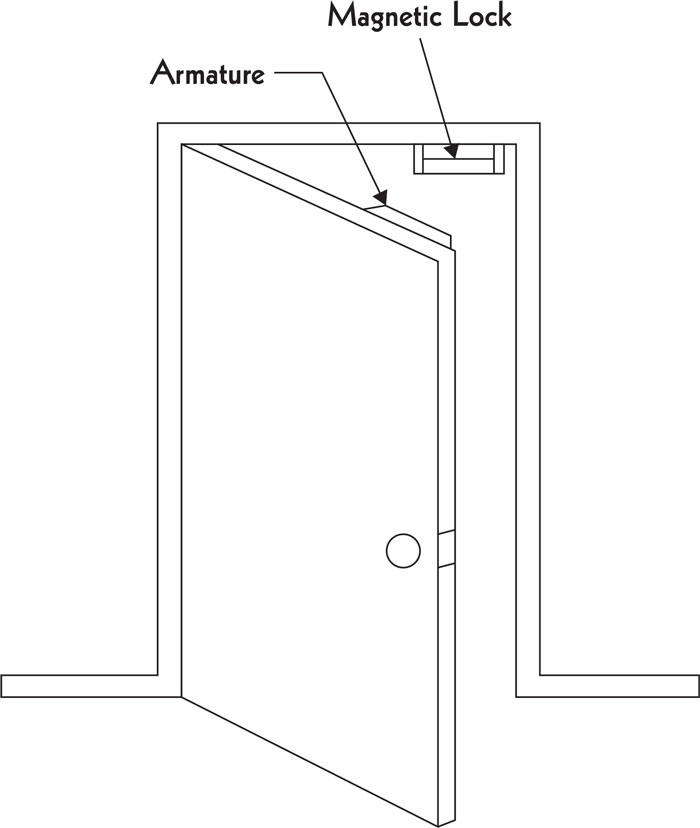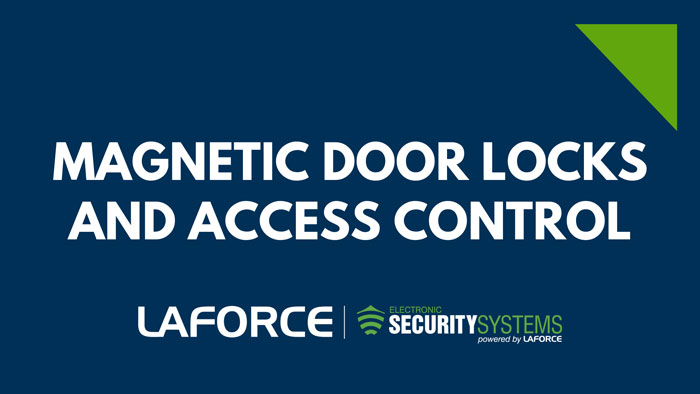Magnetic door locks, often referred to as maglocks, use constant power to secure an opening. They consist of an electromagnet and an armature; the magnet is typically mounted on the head of the frame and the armature is a flat piece of metal attached to the door. When the door is closed, the armature connects to the magnet and a power source ensures the magnetic force stays intact to hold the door shut.
Click on image to make larger.

Magnetic Door Locks and Loss of Power:
Magnetic locks are Fail Safe. This means that when the power fails or is interrupted, the magnet releases and people can freely use the opening. Because magnetic locks secure a door from both the egress and ingress side, they are also required to be integrated into the building’s fire alarm, automatic fire detection, or sprinkler systems. When one of these systems is activated, the system cuts the power to the lock, the magnetic force releases, and the door can be opened. This allows users to utilize the opening during an emergency.
Safely Managing Magnetic Locks:
To safely manage the operation of a maglock, a few other components are required.
Sensor Controlled Magnetic Locks
- A sensor/detector is installed on the egress side of the opening to release the maglock when it senses a person approaching. The maglock must release whenever signaled by the sensor or if there is a loss of power.
- A manually operated emergency button or pull station is located near the opening. When used, power to the lock is immediately cut, allowing free egress. The exact location of the button in relation to the door is defined in the model building codes, but it must be clearly identified with signage that reads “Push to Exit”.
Hardware Controlled Magnetic Locks
- In this case, hardware is mounted directly to the door on the egress side. The maglock releases whenever the hardware is used or if there is a loss of power to the locking system.
- This door hardware must have an obvious method of operation that can be seen under all lighting conditions, does not require more than one motion, and can be operated with one hand.
Considerations for Incorporating a Magnetic Door Lock into your Security System:
- Is it an exterior door?
- Is the door going to be locked electronically?
- Is the opening a path of egress?
- Is it a double leaf door?
- Is it a double egress opening, meaning the doors can only swing in opposite directions?
- Are the doors made of tempered glass with no frame or mullion?
- Is the door exiting a room or building classified as high-hazard?
Magnetic locks must also comply with local, state, and national fire and building codes. Your local Authority Having Jurisdiction (AHJ) will also require electrical plans and permits to ensure that the maglocks provide safe egress under all conditions.
The security experts at LaForce can help you decide if a magnetic lock is the best option for securing your building. We can also provide access control, electrified hardware, video surveillance, and alarm/intercom systems to fit your needs. Check out our linecard for a full list of products and services that we offer, and contact us today to get started.



Follow Us